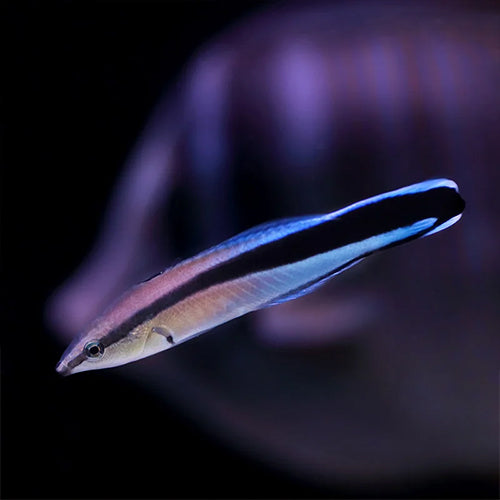- :SKU
- :بائع Fiora Aquatic
Blue Cleaner Wrasse
وصف المنتج
Species Profile
- Scientific Name: Labroides dimidiatus
- Common Name: Blue Cleaner Wrasse
- Adult Size: 4–5 inches (10–13 cm)
-
Life Expectancy: Up to 4 years in captivity (though often shorter in poor conditions)
Longer in the wild due to natural feeding behaviors -
Habitat:
- Found throughout Indo-Pacific coral reefs
- Commonly seen on cleaning stations, where they remove parasites from larger reef fish
-
Prefer clear, shallow reef environments with lots of rockwork and coral
Tank Requirements
- Minimum Tank Size: 55 gallons (larger preferred for long-term care and tankmate compatibility)
- Ideal Temperature: 75–82°F (24–28°C)
- pH Range: 8.1–8.4
- Water Hardness: 8–12 dKH
-
Temperament:
- Peaceful, especially toward other species
- May exhibit cleaning behavior on tankmates
- Best kept singly—can be aggressive toward other wrasses of the same kind
-
Needs a peaceful community or reef tank
Diet & Nutrition
- In the wild, feeds primarily on parasites, dead tissue, and scales of larger fish
- In captivity:
- Can be very difficult to feed, often refusing prepared foods
- Best offered live foods initially (brine shrimp, blackworms)
- May accept frozen mysis, enriched brine shrimp, and finely chopped seafood over time
- Some may learn to eat high-protein pellets or flakes, but many do not
- Frequent small feedings are essential
-
Ideal for experienced aquarists only due to feeding challenges
Breeding & Spawning
- Not typically bred in home aquariums
- In the wild, they are protogynous hermaphrodites (females can become males)
- Harem-based spawning behavior—one dominant male with several females
-
Requires very large tanks and specific environmental cues to trigger spawning
Appearance
- Long, slender body with a striking blue and black horizontal stripe
- Iridescent blue coloration on the lower body
- Black stripe runs from the snout through the eye to the tail
-
Elegant, fluid swimmers
Distinctive Features
- Known for their cleaning behavior—a rare behavior among reef fish
- May be seen “dancing” in front of larger fish to invite cleaning
- Fascinating and unique, but notoriously hard to keep
-
Should never be collected irresponsibly, as wild populations play a critical reef role
لدي سؤال؟

Blue Cleaner Wrasse


